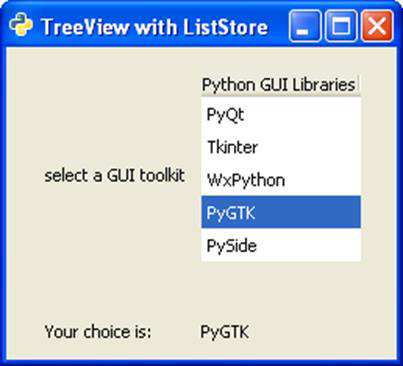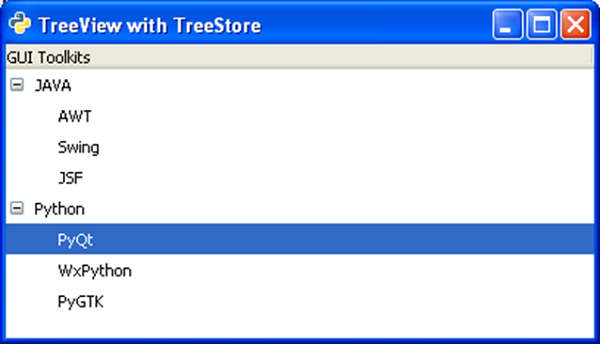
- PyGTK Tutorial
- PyGTK - Home
- PyGTK - Introduction
- PyGTK - Environment
- PyGTK - Hello World
- PyGTK - Important Classes
- PyGTK - Window Class
- PyGTK - Button Class
- PyGTK - Label CLass
- PyGTK - Entry Class
- PyGTK - Signal Handling
- PyGTK - Event Handling
- PyGTK - Containers
- PyGTK - Box Class
- PyGTK - ButtonBox Class
- PyGTK - Alignment Class
- PyGTK - EventBox Class
- PyGTK - Layout Class
- PyGTK - ComboBox Class
- PyGTK - ToggleButton Class
- PyGTK - CheckButton Class
- PyGTK - RadioButton Class
- PyGTK - MenuBar, Menu & MenuItem
- PyGTK - Toolbar Class
- PyGTK - Adjustment Class
- PyGTK - Range Class
- PyGTK - Scale Class
- PyGTK - Scrollbar Class
- PyGTK - Dialog Class
- PyGTK - MessageDialog Class
- PyGTK - AboutDialog Class
- PyGTK - Font Selection Dialog
- PyGTK - Color Selection Dialog
- PyGTK - File Chooser Dialog
- PyGTK - Notebook Class
- PyGTK - Frame Class
- PyGTK - AspectFrame Class
- PyGTK - TreeView Class
- PyGTK - Paned Class
- PyGTK - Statusbar Class
- PyGTK - ProgressBar Class
- PyGTK - Viewport Class
- PyGTK - Scrolledwindow Class
- PyGTK - Arrow Class
- PyGTK - Image Class
- PyGTK - DrawingArea Class
- PyGTK - SpinButton Class
- PyGTK - Calendar Class
- PyGTK - Clipboard Class
- PyGTK - Ruler Class
- PyGTK - Timeout
- PyGTK - Drag and Drop
- PyGTK Useful Resources
- PyGTK - Quick Guide
- PyGTK - Useful Resources
- PyGTK - Discussion
PyGTK - TreeView Class
The Treeview widget displays contents of a model implementing the gtk.TreeModel interface. PyGTK provides the following types of models −
- gtk.ListStore
- gtk.TreeStore
- gtk.TreeModelSort
ListStore is a list model. When associated with a gtk.TreeView widget, it produces a List box containing the items to be selected from. A gtk.ListStore object is declared with following syntax −
store = gtk.ListStore(column_type)
A list may have multiple columns, the predefined type constants are −
- gobject.TYPE_BOOLEAN
- gobject.TYPE_BOXED
- gobject.TYPE_CHAR
- gobject.TYPE_DOUBLE
- gobject.TYPE_ENUM
- gobject.TYPE_FLOAT
- gobject.TYPE_INT
- gobject.TYPE_LONG
- gobject.TYPE_NONE
- gobject.TYPE_OBJECT
- gobject.TYPE_STRING
- gobject.TYPE_UCHAR
- gobject.TYPE_UINT
- gobject.TYPE_ULONG
- gtk.gdk.pixbuf etc.
For example, a ListStore object to store string items is declared as −
store = gtk.ListStore(gobject.TYPE_STRING
In order to add items in the store, append() methods are used −
store.append (["item 1"])
TreeStore is a model for multi-columned Tree widget. For example, the following statement creates a store with one column having string item.
Store = gtk.TreeStore(gobject.TYPE_STRING)
In order to add items in a TreeStore, use the append() method. The append() method has two parameters, parent and row. To add toplevel item, parent is None.
row1 = store.append(None, ['row1'])
You need to repeat this statement to add multiple rows.
In order to add child rows, pass the toplevel row as parent parameter to the append() method −
childrow = store.append(row1, ['child1'])
You need to repeat this statement to add multiple child rows.
Now, create a TreeView widget and use the above TreeStore object as model.
treeview = gtk.TreeView(store)
We now have to create TreeViewColumn to display store data. The object of gtk.TreeViewColumn manages header and the cells using gtk.CelRenderer. TreeViewColumn object is created using the following constructor −
gtk.TreeViewColumn(title, cell_renderer,…)
In addition to title and renderer, it takes zero or more attribute=column pairs to specify from which tree model column the attribute's value is to be retrieved. These parameters can also be set using methods of TreeViewColumn class given below.
A gtk.CellRenderer is a base class for a set of objects for rendering different types of data. The derived classes are CellRendererText, CellRendererPixBuf and CellRendererToggle.
The following methods of the TreeViewColumn class are used to configure its object −
TreeViewColumn.pack_start(cell, expand = True) − This method packs the CellRenderer object into the beginning column. If expand parameter is set to True, columns entire allocated space is assigned to cell.
TreeViewColumn.add_attribute(cell, attribute, column) − This method adds an attribute mapping to the list in the tree column. The column is the column of the tree model.
TreeViewColumn.set_attributes() − This method sets the attribute locations of the renderer using the attribute = column pairs
TreeViewColumn.set_visible() − If True, the treeview column is visible
TreeViewColumn.set_title() − This method sets the "title" property to the value specified.
TreeViewColumn.set_lickable() − If set to True, the header can take keyboard focus, and be clicked.
TreeViewColumn.set_alignment(xalign) − This method sets the "alignment" property to the value of xalign.
The "clicked" signal is emitted when the user clicks on the treeviewcolumn header button.
After having configured the TreeViewColumn object, it is added to the TreeView widget using the append_column() method.
The following are the important methods of the TreeView class −
TreevVew.set_model() − This sets the "model" property for the treeview. If the treeview already has a model set, this method will remove it before setting the new model. If model is None, it will unset the old model.
TreeView.set_header_clickable() − If set to True, the column title buttons can be clicked.
TreeView.append_column() − This appends the specified TreeViewColumn to the list of columns.
TreeView.remove_column() − This removes the specified column from the treeview.
TreeView.insert_column() − This inserts the specified column into the treeview at the location specified by position.
The TreeView widget emits the following signals −
| cursor-changed | This is emitted when the cursor moves or is set. |
| expand-collapse-cursor-row | This is emitted when the row at the cursor needs to be expanded or collapsed. |
| row-activated | This is emitted when the user double clicks a treeview row |
| row-collapsed | This is emitted when a row is collapsed by the user or programmatic action. |
| row-expanded | This is emitted when a row is expanded via the user or programmatic action. |
Two examples of the TreeView widget are given below. The first example uses a ListStore to produce a simple ListView.
Here a ListStore object is created and string items are added to it. This ListStore object is used as model for TreeView object −
store = gtk.ListStore(str) treeView = gtk.TreeView() treeView.set_model(store)
Then a CellRendererText is added to a TreeViewColumn object and the same is appended to TreeView.
rendererText = gtk.CellRendererText()
column = gtk.TreeViewColumn("Name", rendererText, text = 0)
treeView.append_column(column)
TreeView Object is placed on the toplevel window by adding it to a Fixed container.
Example 1
Observe the following code −
import pygtk
pygtk.require('2.0')
import gtk
class PyApp(gtk.Window):
def __init__(self):
super(PyApp, self).__init__()
self.set_title("TreeView with ListStore")
self.set_default_size(250, 200)
self.set_position(gtk.WIN_POS_CENTER)
store = gtk.ListStore(str)
store.append (["PyQt"])
store.append (["Tkinter"])
store.append (["WxPython"])
store.append (["PyGTK"])
store.append (["PySide"])
treeView = gtk.TreeView()
treeView.set_model(store)
rendererText = gtk.CellRendererText()
column = gtk.TreeViewColumn("Python GUI Libraries", rendererText, text=0)
treeView.append_column(column)
fixed = gtk.Fixed()
lbl = gtk.Label("select a GUI toolkit")
fixed.put(lbl, 25,75)
fixed.put(treeView, 125,15)
lbl2 = gtk.Label("Your choice is:")
fixed.put(lbl2, 25,175)
self.label = gtk.Label("")
fixed.put(self.label, 125,175)
self.add(fixed)
treeView.connect("row-activated", self.on_activated)
self.connect("destroy", gtk.main_quit)
self.show_all()
def on_activated(self, widget, row, col):
model = widget.get_model()
text = model[row][0]
self.label.set_text(text)
def main():
gtk.main()
return
if __name__ == "__main__":
bcb = PyApp()
main()
The item selected by the user is displayed on a label in the window as the on_activated callback function is invoked.

Example 2
The second example builds a hierarchical TreeView from a TreeStore. This program follows the same sequence of building the store, setting it as model for TreeView, designing a TreeViewColumn and appending it to TreeView.
import gtk
class PyApp(gtk.Window):
def __init__(self):
super(PyApp, self).__init__()
self.set_title("TreeView with TreeStore")
self.set_size_request(400,200)
self.set_position(gtk.WIN_POS_CENTER)
vbox = gtk.VBox(False, 5)
# create a TreeStore with one string column to use as the model
store = gtk.TreeStore(str)
# add row
row1 = store.append(None, ['JAVA'])
#add child rows
store.append(row1,['AWT'])
store.append(row1,['Swing'])
store.append(row1,['JSF'])
# add another row
row2 = store.append(None, ['Python'])
store.append(row2,['PyQt'])
store.append(row2,['WxPython'])
store.append(row2,['PyGTK'])
# create the TreeView using treestore
treeview = gtk.TreeView(store)
tvcolumn = gtk.TreeViewColumn('GUI Toolkits')
treeview.append_column(tvcolumn)
cell = gtk.CellRendererText()
tvcolumn.pack_start(cell, True)
tvcolumn.add_attribute(cell, 'text', 0)
vbox.add(treeview)
self.add(vbox)
self.connect("destroy", gtk.main_quit)
self.show_all()
PyApp()
gtk.main()
The following TreeView is displayed as an output −
